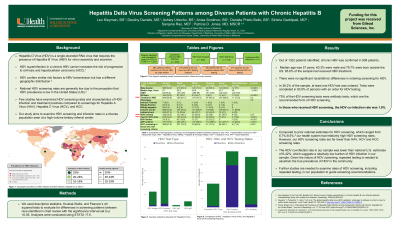Monday Poster Session
Category: Liver
P2364 - Hepatitis Delta Virus Screening Patterns Among Patients With Chronic Hepatitis B
Monday, October 23, 2023
10:30 AM - 4:15 PM PT
Location: Exhibit Hall

Has Audio

Leo S. Kleyman, BS
University of Miami Miller School of Medicine
Miami, FL
Presenting Author(s)
Leo S. Kleyman, BS1, Destiny Daniels, BS1, Ashley Urtecho, BS1, Anisa Sookhoo, BS1, Daniela Prieto Bello, BS1, Sirisha Gaddipati, MD1, Sanjana Rao, MD2, Patricia D. Jones, MD, MSCR1
1University of Miami Miller School of Medicine, Miami, FL; 2University of Miami, Miami, FL
Introduction: Hepatitis D Virus (HDV) superinfection in a chronic hepatitis B virus (HBV) carrier increases the risk of progression to cirrhosis and hepatocellular carcinoma (HCC). However, HDV screening rates are generally low due to the perception that HDV prevalence is low in the United States (US). Few studies have examined HDV screening rates and characteristics of HDV infection and treatment practices compared to screenings for Hepatitis A Virus (HAV), Hepatitis C Virus (HCV), and HCC. Our study aims to examine HDV screening and infection rates in a diverse population seen at a high-volume tertiary referral center.
Methods: Using informatics, we identified patients with possible HBV based on ICD-10 code B18.1 seen from May 2010 to July 2021. We performed retrospective chart review to confirm chronic HBV infection, identify whether HDV testing was ordered, and characterize which HDV tests were ordered. We used descriptive statistics, Kruskal-Wallis and Pearson’s chi squared tests as appropriate. Analyses were conducted using STATA 17.0.
Results: Out of 1322 patients, chronic HBV was confirmed in 930. Median age was 57 years, 60.3% were male and 20.3% were born in the US. Nearly two-thirds had received HBV treatment, 65.6%. The most ordered HDV screening test was HDV antibody. There were no significant racial/ethnic differences in ordering screening for HDV. In 35.3% of the sample, at least one HDV test was ordered. Tests were completed in 83.8% of persons with an order for HDV testing. In those who received HDV screening, the HDV infection rate was 6.7%. Of note, this rate is higher than the HCV infection rate, 5.5%. Persons with HDV were born in 9 different countries of origin, with the highest proportion of individuals coming from the United States (n = 4), then Cuba and Venezuela (n = 3). HDV-positive patients were White (n=7) or Hispanic (n=8).
In contrast, tests for HCV and HAV were ordered in 64.2% and 71.7% of the sample, respectively. Screening for HCC was ordered in 67.5% of those individuals with indications for HCC screening.
Discussion: Compared to prior national estimates for HDV screening, which ranged from 6.7%- 8.5%, our system had relatively high HDV screening rates. However, HDV screening rates are far lower than HAV, HCV and HCC screening rates. Importantly, HDV infection rates were higher than national reports, reinforcing the urgency to screen and detect HDV to identify those who would benefit from treatment to reduce risk of cirrhosis and HCC.
Disclosures:
Leo S. Kleyman, BS1, Destiny Daniels, BS1, Ashley Urtecho, BS1, Anisa Sookhoo, BS1, Daniela Prieto Bello, BS1, Sirisha Gaddipati, MD1, Sanjana Rao, MD2, Patricia D. Jones, MD, MSCR1. P2364 - Hepatitis Delta Virus Screening Patterns Among Patients With Chronic Hepatitis B, ACG 2023 Annual Scientific Meeting Abstracts. Vancouver, BC, Canada: American College of Gastroenterology.
1University of Miami Miller School of Medicine, Miami, FL; 2University of Miami, Miami, FL
Introduction: Hepatitis D Virus (HDV) superinfection in a chronic hepatitis B virus (HBV) carrier increases the risk of progression to cirrhosis and hepatocellular carcinoma (HCC). However, HDV screening rates are generally low due to the perception that HDV prevalence is low in the United States (US). Few studies have examined HDV screening rates and characteristics of HDV infection and treatment practices compared to screenings for Hepatitis A Virus (HAV), Hepatitis C Virus (HCV), and HCC. Our study aims to examine HDV screening and infection rates in a diverse population seen at a high-volume tertiary referral center.
Methods: Using informatics, we identified patients with possible HBV based on ICD-10 code B18.1 seen from May 2010 to July 2021. We performed retrospective chart review to confirm chronic HBV infection, identify whether HDV testing was ordered, and characterize which HDV tests were ordered. We used descriptive statistics, Kruskal-Wallis and Pearson’s chi squared tests as appropriate. Analyses were conducted using STATA 17.0.
Results: Out of 1322 patients, chronic HBV was confirmed in 930. Median age was 57 years, 60.3% were male and 20.3% were born in the US. Nearly two-thirds had received HBV treatment, 65.6%. The most ordered HDV screening test was HDV antibody. There were no significant racial/ethnic differences in ordering screening for HDV. In 35.3% of the sample, at least one HDV test was ordered. Tests were completed in 83.8% of persons with an order for HDV testing. In those who received HDV screening, the HDV infection rate was 6.7%. Of note, this rate is higher than the HCV infection rate, 5.5%. Persons with HDV were born in 9 different countries of origin, with the highest proportion of individuals coming from the United States (n = 4), then Cuba and Venezuela (n = 3). HDV-positive patients were White (n=7) or Hispanic (n=8).
In contrast, tests for HCV and HAV were ordered in 64.2% and 71.7% of the sample, respectively. Screening for HCC was ordered in 67.5% of those individuals with indications for HCC screening.
Discussion: Compared to prior national estimates for HDV screening, which ranged from 6.7%- 8.5%, our system had relatively high HDV screening rates. However, HDV screening rates are far lower than HAV, HCV and HCC screening rates. Importantly, HDV infection rates were higher than national reports, reinforcing the urgency to screen and detect HDV to identify those who would benefit from treatment to reduce risk of cirrhosis and HCC.
Disclosures:
Leo Kleyman indicated no relevant financial relationships.
Destiny Daniels indicated no relevant financial relationships.
Ashley Urtecho indicated no relevant financial relationships.
Anisa Sookhoo indicated no relevant financial relationships.
Daniela Prieto Bello indicated no relevant financial relationships.
Sirisha Gaddipati indicated no relevant financial relationships.
Sanjana Rao indicated no relevant financial relationships.
Patricia Jones indicated no relevant financial relationships.
Leo S. Kleyman, BS1, Destiny Daniels, BS1, Ashley Urtecho, BS1, Anisa Sookhoo, BS1, Daniela Prieto Bello, BS1, Sirisha Gaddipati, MD1, Sanjana Rao, MD2, Patricia D. Jones, MD, MSCR1. P2364 - Hepatitis Delta Virus Screening Patterns Among Patients With Chronic Hepatitis B, ACG 2023 Annual Scientific Meeting Abstracts. Vancouver, BC, Canada: American College of Gastroenterology.
